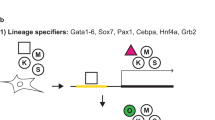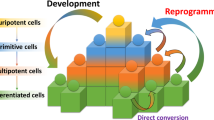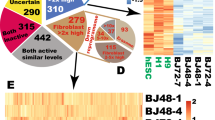Abstract
Ectopic expression of defined sets of genetic factors can reprogram somatic cells to induced pluripotent stem (iPS) cells that closely resemble embryonic stem (ES) cells. The low efficiency with which iPS cells are derived hinders studies on the molecular mechanism of reprogramming, and integration of viral transgenes, in particular the oncogenes c-Myc and Klf4, may handicap this method for human therapeutic applications. Here we report that valproic acid (VPA), a histone deacetylase inhibitor, enables reprogramming of primary human fibroblasts with only two factors, Oct4 and Sox2, without the need for the oncogenes c-Myc or Klf4. The two factor–induced human iPS cells resemble human ES cells in pluripotency, global gene expression profiles and epigenetic states. These results support the possibility of reprogramming through purely chemical means, which would make therapeutic use of reprogrammed cells safer and more practical.
This is a preview of subscription content, access via your institution
Access options
Subscribe to this journal
Receive 12 print issues and online access
$209.00 per year
only $17.42 per issue
Buy this article
- Purchase on Springer Link
- Instant access to full article PDF
Prices may be subject to local taxes which are calculated during checkout






Similar content being viewed by others
References
Gurdon, J.B., Elsdale, T.R. & Fischberg, M. Sexually mature individuals of Xenopus laevis from the transplantation of single somatic nuclei. Nature 182, 64–65 (1958).
Wilmut, I. et al. Viable offspring derived from fetal and adult mammalian cells. Nature 385, 810–813 (1997).
Wakayama, T. et al. Full-term development of mice from enucleated oocytes injected with cumulus cell nuclei. Nature 394, 369–374 (1998).
Byrne, J.A. et al. Producing primate embryonic stem cells by somatic cell nuclear transfer. Nature 450, 497–502 (2007).
Tada, M. et al. Nuclear reprogramming of somatic cells by in vitro hybridization with ES cells. Curr. Biol. 11, 1553–1558 (2001).
Cowan, C.A., Atienza, J., Melton, D.A. & Eggan, K. Nuclear reprogramming of somatic cells after fusion with human embryonic stem cells. Science 309, 1369–1373 (2005).
Takahashi, K. & Yamanaka, S. Induction of pluripotent stem cells from mouse embryonic and adult fibroblast cultures by defined factors. Cell 126, 663–676 (2006).
Okita, K., Ichisaka, T. & Yamanaka, S. Generation of germline-competent induced pluripotent stem cells. Nature 448, 313–317 (2007).
Maherali, N. et al. Directly Reprogrammed Fibroblasts Show Global Epigenetic Remodeling and Widespread Tissue Contribution. Cell Stem Cell 1, 55–70 (2007).
Wernig, M. et al. In vitro reprogramming of fibroblasts into a pluripotent ES-cell-like state. Nature 448, 318–324 (2007).
Takahashi, K. et al. Induction of pluripotent stem cells from adult human fibroblasts by defined factors. Cell 131, 861–872 (2007).
Yu, J. et al. Induced pluripotent stem cell lines derived from human somatic cells. Science 318, 1917–1920 (2007).
Park, I.H. et al. Reprogramming of human somatic cells to pluripotency with defined factors. Nature 451, 141–146 (2008).
Lowry, W.E. et al. Generation of human induced pluripotent stem cells from dermal fibroblasts. Proc. Natl. Acad. Sci. USA 105, 2883–2888 (2008).
Nakagawa, M. et al. Generation of induced pluripotent stem cells without Myc from mouse and human fibroblasts. Nat. Biotechnol. 26, 101–106 (2008).
Wernig, M., Meissner, A., Cassady, J.P. & Jaenisch, R. c-Myc is dispensable for direct reprogramming of mouse fibroblasts. Cell Stem Cell 2, 10–12 (2008).
Kim, J.B. et al. Pluripotent stem cells induced from adult neural stem cells by reprogramming with two factors. Nature 454, 646–650 (2008).
Shi, Y. et al. A combined chemical and genetic approach for the generation of induced pluripotent stem cells. Cell Stem Cell 2, 525–528 (2008).
Eminli, S. et al. Reprogramming of neural progenitor cells into iPS cells in the absence of exogenous Sox2 expression. Stem Cells, published online, doi:10.1634/stemcells.2008-0317 (17 July 2008).
Nunes, M.C. et al. Identification and isolation of multipotential neural progenitor cells from the subcortical white matter of the adult human brain. Nat. Med. 9, 439–447 (2003).
Huangfu, D. et al. Induction of pluripotent stem cells by defined factors is greatly improved by small-molecule compounds. Nat. Biotechnol. 26, 795–797 (2008).
Mikkelsen, T.S. et al. Dissecting direct reprogramming through integrative genomic analysis. Nature 454, 49–55 (2008).
Marson, A. et al. Wnt signaling promotes reprogramming of somatic cells to pluripotency. Cell Stem Cell 3, 132–135 (2008).
Meissner, A., Wernig, M. & Jaenisch, R. Direct reprogramming of genetically unmodified fibroblasts into pluripotent stem cells. Nat. Biotechnol. 25, 1177–1181 (2007).
Blelloch, R., Venere, M., Yen, J. & Ramalho-Santos, M. Generation of Induced Pluripotent Stem Cells in the Absence of Drug Selection. Cell Stem Cell 1, 245–247 (2007).
Amit, M. et al. Clonally derived human embryonic stem cell lines maintain pluripotency and proliferative potential for prolonged periods of culture. Dev. Biol. 227, 271–278 (2000).
Thomson, J.A. et al. Embryonic stem cell lines derived from human blastocysts. Science 282, 1145–1147 (1998).
Kawasaki, H. et al. Induction of midbrain dopaminergic neurons from ES cells by stromal cell-derived inducing activity. Neuron 28, 31–40 (2000).
Osafune, K. et al. Marked differences in differentiation propensity among human embryonic stem cell lines. Nat. Biotechnol. 26, 313–315 (2008).
D'Amour, K.A. et al. Efficient differentiation of human embryonic stem cells to definitive endoderm. Nat. Biotechnol. 23, 1534–1541 (2005).
Cowan, C.A. et al. Derivation of embryonic stem-cell lines from human blastocysts. N. Engl. J. Med. 350, 1353–1356 (2004).
Deb-Rinker, P. et al. Sequential DNA methylation of the Nanog and Oct-4 upstream regions in human NT2 cells during neuronal differentiation. J. Biol. Chem. 280, 6257–6260 (2005).
Freberg, C.T., Dahl, J.A., Timoskainen, S. & Collas, P. Epigenetic reprogramming of OCT4 and NANOG regulatory regions by embryonal carcinoma cell extract. Mol. Biol. Cell 18, 1543–1553 (2007).
Rossant, J. Stem cells: the magic brew. Nature 448, 260–262 (2007).
Zaehres, H. & Scholer, H.R. Induction of pluripotency: from mouse to human. Cell 131, 834–835 (2007).
Perry, A.C. Induced pluripotency and cellular alchemy. Nat. Biotechnol. 24, 1363–1364 (2006).
Leeman, B.A. & Cole, A.J. Advancements in the treatment of epilepsy. Annu. Rev. Med. 59, 503–523 (2008).
Boyer, L.A. et al. Core transcriptional regulatory circuitry in human embryonic stem cells. Cell 122, 947–956 (2005).
Watanabe, K. et al. A ROCK inhibitor permits survival of dissociated human embryonic stem cells. Nat. Biotechnol. 25, 681–686 (2007).
Acknowledgements
D.H. and D.A.M. conceived the experiments and wrote the manuscript. D.H., K.O., R.M., W.G., A.E., S.C. and W.M. performed experiments.
Author information
Authors and Affiliations
Contributions
D.A.M. is a Howard Hughes Medical Institute Investigator. D.H. is funded by the Helen Hay Whitney Foundation and Novartis Institutes for BioMedical Research. S.C. is supported by the Juvenile Diabetics Research Foundation. The authors thank Anastasie Kweudjeu for assistance with micoarray analysis, Konrad Hochedlinger for providing probes for Southern blot analysis, Shinya Yamanaka for providing viral vectors through Addgene and Robert Weinberg for support of this study. Some monoclonal antibodies were obtained from the Developmental Studies Hybridoma Bank, which was developed under the auspices of the National Institute of Child Health and Human Development and is maintained by The University of Iowa, Department of Biological Sciences.
Corresponding author
Supplementary information
Supplementary Text and Figures
Figures 1–6, Tables 1–6 (PDF 643 kb)
Rights and permissions
About this article
Cite this article
Huangfu, D., Osafune, K., Maehr, R. et al. Induction of pluripotent stem cells from primary human fibroblasts with only Oct4 and Sox2. Nat Biotechnol 26, 1269–1275 (2008). https://doi.org/10.1038/nbt.1502
Received:
Accepted:
Published:
Issue Date:
DOI: https://doi.org/10.1038/nbt.1502
This article is cited by
-
Stem Cell-Based Strategies: The Future Direction of Bioartificial Liver Development
Stem Cell Reviews and Reports (2024)
-
Induced pluripotent stem cells: ex vivo models for human diseases due to mitochondrial DNA mutations
Journal of Biomedical Science (2023)
-
A fast chemical reprogramming system promotes cell identity transition through a diapause-like state
Nature Cell Biology (2023)
-
Therapeutic Potential of Extracellular Vesicles from Different Stem Cells in Chronic Wound Healing
Stem Cell Reviews and Reports (2023)
-
Generation of neural organoids for spinal-cord regeneration via the direct reprogramming of human astrocytes
Nature Biomedical Engineering (2022)



